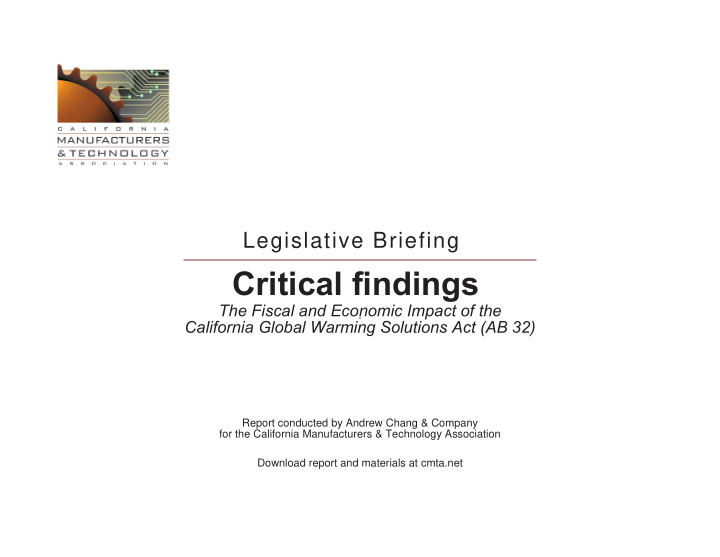



Legislative Briefing Critical findings The Fiscal and Economic Impact of the California Global Warming Solutions Act (AB 32) Report conducted by Andrew Chang & Company for the California Manufacturers & Technology Association Download report and materials at cmta.net
$3,400 in annual family costs by 2020 $3,400 from lost earnings $900 from increased energy and transit prices Key Observations $2,700 AB 32 will increase family costs for goods and $700 services by over $2,500 in 2020. $2,500 $2,100 In addition, families will lose an average of $900 $600 in wages from a slowing economy. $2,000 In total, AB 32 will impose $1,700 over $3,400 of economic difficulty on the average $400 $1,400 $1,600 California family in 2020. $400 This is equal to two and $1,000 a half extra mortgage $1,200 payments for the average $300 family. $1,000 $700 $200 $700 Source: Appendix A $400 Notes: $500 $100 Based on average household of 2.89 people $300 Minor discrepancies in #’s are $0 the result of rounding 2012 2013 2014 2015 2016 2017 2018 2019 2020
$35 billion in annual 2020 $35.3 direct costs on billion consumers, businesses, and government $27.6 Total 2012-2020 $22.0 $135.8 billion $16.8 $13.4 $9.8 $7.0 $4.0 billion $0 2012 2013 2014 2015 2016 2017 2018 2019 2020 Source: Appendix A
262,000 lost jobs from AB 32 by 2020 2012 0 2013 -35,000 2014 -58,000 2015 -82,000 2016 -107,000 Key Observations 2017 -129,000 AB 32 will eliminate 262,000 jobs by 2020 due to a slowing 2018 economy. -166,000 The 2020 job loss is equivalent to the number of jobs currently in 2019 California’s -206,000 semiconductor manufacturing and building construction industries combined. Lost jobs by 2020 -262,000 Annual job losses increase by an average of 33 thousand jobs per year. Source: Appendix A
$21 billion in lost state & local revenues from AB 32 by 2020 2012 2013 2014 2015 2016 2017 2018 2019 2020 -$0.2 billion -$0.5 -$0.8 -$1.5 Key Observations -$2.4 Due to the slow down in economic activity, and lost earnings, AB 32 will reduce state and local tax revenues by -$3.6 over $7 billion annually in 2020. This is more than the state’s 2012-2020 General Fund expenditures for $21 higher education, labor and workforce development, natural resources, environmental protection and business, billion transportation and housing combined -$5.2 Cumulatively, this amounts to over $21 billion in lost state and local tax revenues. This is as much money as the state projects to spend on higher education between 2011 and 2016 Source: Appendix A In 2020 the annual revenue -$7.4 loss is increasing by billion approximately 40% per year
California’s GSP loss from AB 32 will equal the Great Recession losses the state suffered from 2007 to 2009 Great Recession AB 32 GSP loss GSP loss 2007-09 2012-20 $90 billion $153 billion 5.1% 5.6% Source: Appendix A
Conclusions Though the goals of AB 32 are ambitious, ARB’s programs to meet those goals will cause significant damage to California’s economy in a best case scenario and could devastate California’s economy in a worst, but not implausible, scenario. Even under our optimistic scenario, ARB’s programs as they are presently constructed will cause the loss of 5.6 percent of GSP and 262,000 jobs by 2020. Moreover, the programs will cost the average California family $3,400/year and lead to over $7 billion in lost state and local government revenues in 2020. ARB has been actively working to define its programs to implement the requirements of AB 32. However, ARB has not subsequently assessed the economic impact of the programs. ARB last completed a comprehensive review of AB 32 in 2010 utilizing assumptions and data from 2009. That study concluded that AB 32 would cost only $8 of lost GSP per ton of GHG reduction. (Implicitly, this translates to $4 of direct costs per ton of GHG.) The most recent evidence suggests that costs are significantly higher and our study confirms this. Moreover, since ARB last conducted its study, there has been significant advancements in defining the AB 32 program, including more detail on the implementation program, more accurate data has become available and better information has become available regarding some of the market assumptions that ARB utilized in its study. Virtually every Californian will be impacted by AB 32. Because of the broad impact of AB 32 and because of the high technical nature of AB 32, ARB must work closely with all stakeholder groups and industry experts in order minimize the harm that AB 32 could have on California while maximizing potential benefits of the program. ARB is planning to hold its first auction this November which will make changing the program very difficult to achieve. The Legislature and the Administration must ask whether there are more cost-effective means to achieve the reductions in greenhouse gas emissions. The full report is located at cmta.net You can reach the report author Andrew Chang at 916-538-6091 You can reach CMTA’s Dorothy Rothrock at 916-498-3319 or Jack Stewart at 916-498-3324
Recommend
More recommend